International HRM: Training and Development of Expatriate Employees
VerifiedAdded on 2022/08/23
|9
|2881
|38
Essay
AI Summary
This essay delves into the critical aspects of training and development within the realm of International Human Resource Management (IHRM), specifically focusing on expatriate employees. It underscores the significance of IHRM in preparing individuals for global assignments and achieving organizational objectives. The essay explores various training techniques and methodologies employed by international organizations to equip expatriates with the necessary skills and knowledge to navigate the challenges of working in diverse cultural environments. It highlights the importance of comprehensive training programs, including orientation, cultural sensitivity training, and language acquisition, to facilitate a smooth transition and enhance employee performance. The essay further discusses the challenges expatriate employees face, such as culture shock, language barriers, and family adjustments, and emphasizes the role of HR departments in providing support, resources, and strategies to mitigate these challenges. It also examines the benefits of international assignments, such as increased salary, cross-cultural understanding, and professional development opportunities, while advocating for the implementation of effective training programs to ensure the success and well-being of expatriate employees. The essay concludes by highlighting the importance of a supportive organizational environment in fostering employee satisfaction and retention in international assignments. The essay also discusses training methods like vestibule training, job rotation, brainstorming, role-playing and business games and how they are used in IHRM.
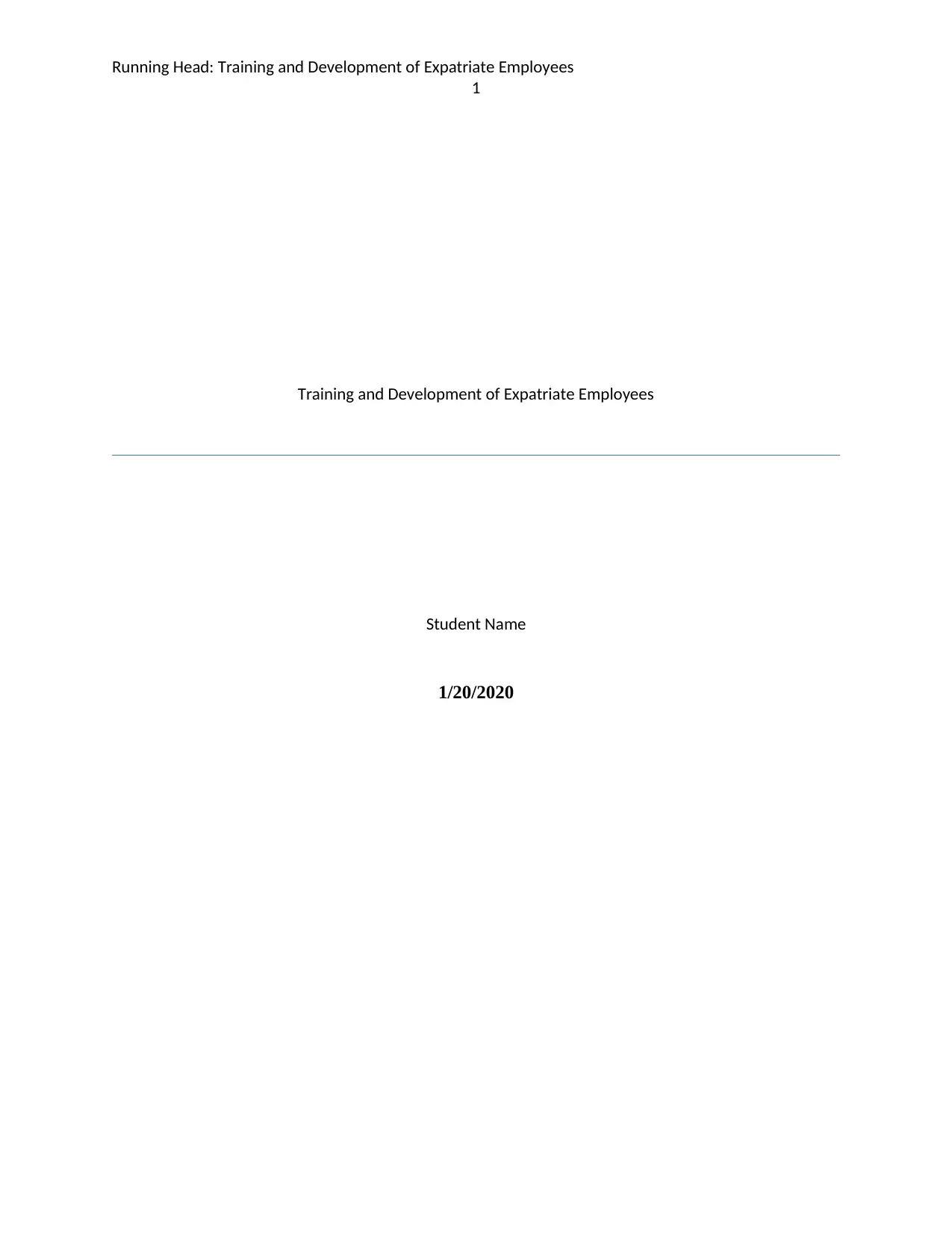
Running Head: Training and Development of Expatriate Employees
1
Training and Development of Expatriate Employees
Student Name
1/20/2020
1
Training and Development of Expatriate Employees
Student Name
1/20/2020
Paraphrase This Document
Need a fresh take? Get an instant paraphrase of this document with our AI Paraphraser
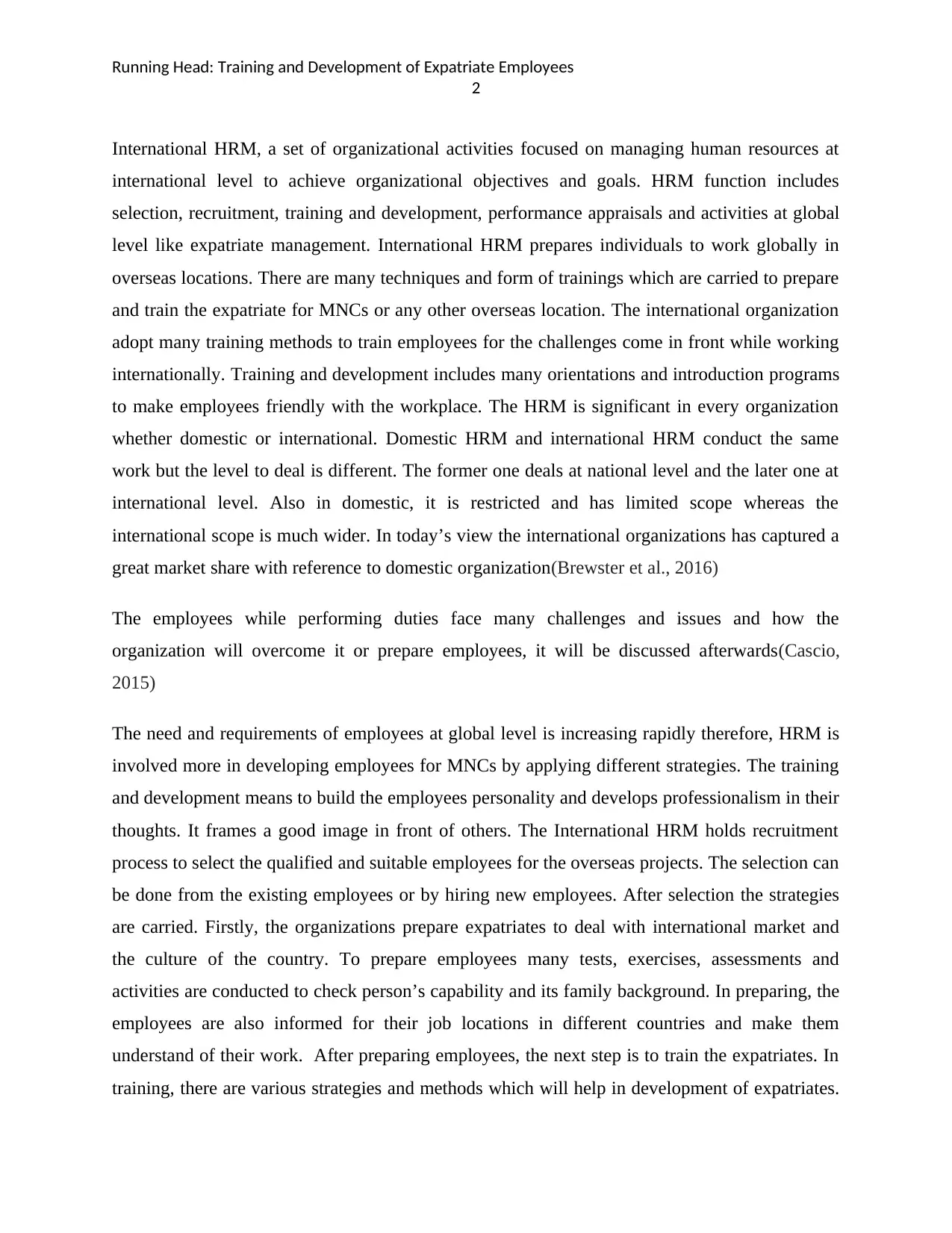
Running Head: Training and Development of Expatriate Employees
2
International HRM, a set of organizational activities focused on managing human resources at
international level to achieve organizational objectives and goals. HRM function includes
selection, recruitment, training and development, performance appraisals and activities at global
level like expatriate management. International HRM prepares individuals to work globally in
overseas locations. There are many techniques and form of trainings which are carried to prepare
and train the expatriate for MNCs or any other overseas location. The international organization
adopt many training methods to train employees for the challenges come in front while working
internationally. Training and development includes many orientations and introduction programs
to make employees friendly with the workplace. The HRM is significant in every organization
whether domestic or international. Domestic HRM and international HRM conduct the same
work but the level to deal is different. The former one deals at national level and the later one at
international level. Also in domestic, it is restricted and has limited scope whereas the
international scope is much wider. In today’s view the international organizations has captured a
great market share with reference to domestic organization(Brewster et al., 2016)
The employees while performing duties face many challenges and issues and how the
organization will overcome it or prepare employees, it will be discussed afterwards(Cascio,
2015)
The need and requirements of employees at global level is increasing rapidly therefore, HRM is
involved more in developing employees for MNCs by applying different strategies. The training
and development means to build the employees personality and develops professionalism in their
thoughts. It frames a good image in front of others. The International HRM holds recruitment
process to select the qualified and suitable employees for the overseas projects. The selection can
be done from the existing employees or by hiring new employees. After selection the strategies
are carried. Firstly, the organizations prepare expatriates to deal with international market and
the culture of the country. To prepare employees many tests, exercises, assessments and
activities are conducted to check person’s capability and its family background. In preparing, the
employees are also informed for their job locations in different countries and make them
understand of their work. After preparing employees, the next step is to train the expatriates. In
training, there are various strategies and methods which will help in development of expatriates.
2
International HRM, a set of organizational activities focused on managing human resources at
international level to achieve organizational objectives and goals. HRM function includes
selection, recruitment, training and development, performance appraisals and activities at global
level like expatriate management. International HRM prepares individuals to work globally in
overseas locations. There are many techniques and form of trainings which are carried to prepare
and train the expatriate for MNCs or any other overseas location. The international organization
adopt many training methods to train employees for the challenges come in front while working
internationally. Training and development includes many orientations and introduction programs
to make employees friendly with the workplace. The HRM is significant in every organization
whether domestic or international. Domestic HRM and international HRM conduct the same
work but the level to deal is different. The former one deals at national level and the later one at
international level. Also in domestic, it is restricted and has limited scope whereas the
international scope is much wider. In today’s view the international organizations has captured a
great market share with reference to domestic organization(Brewster et al., 2016)
The employees while performing duties face many challenges and issues and how the
organization will overcome it or prepare employees, it will be discussed afterwards(Cascio,
2015)
The need and requirements of employees at global level is increasing rapidly therefore, HRM is
involved more in developing employees for MNCs by applying different strategies. The training
and development means to build the employees personality and develops professionalism in their
thoughts. It frames a good image in front of others. The International HRM holds recruitment
process to select the qualified and suitable employees for the overseas projects. The selection can
be done from the existing employees or by hiring new employees. After selection the strategies
are carried. Firstly, the organizations prepare expatriates to deal with international market and
the culture of the country. To prepare employees many tests, exercises, assessments and
activities are conducted to check person’s capability and its family background. In preparing, the
employees are also informed for their job locations in different countries and make them
understand of their work. After preparing employees, the next step is to train the expatriates. In
training, there are various strategies and methods which will help in development of expatriates.
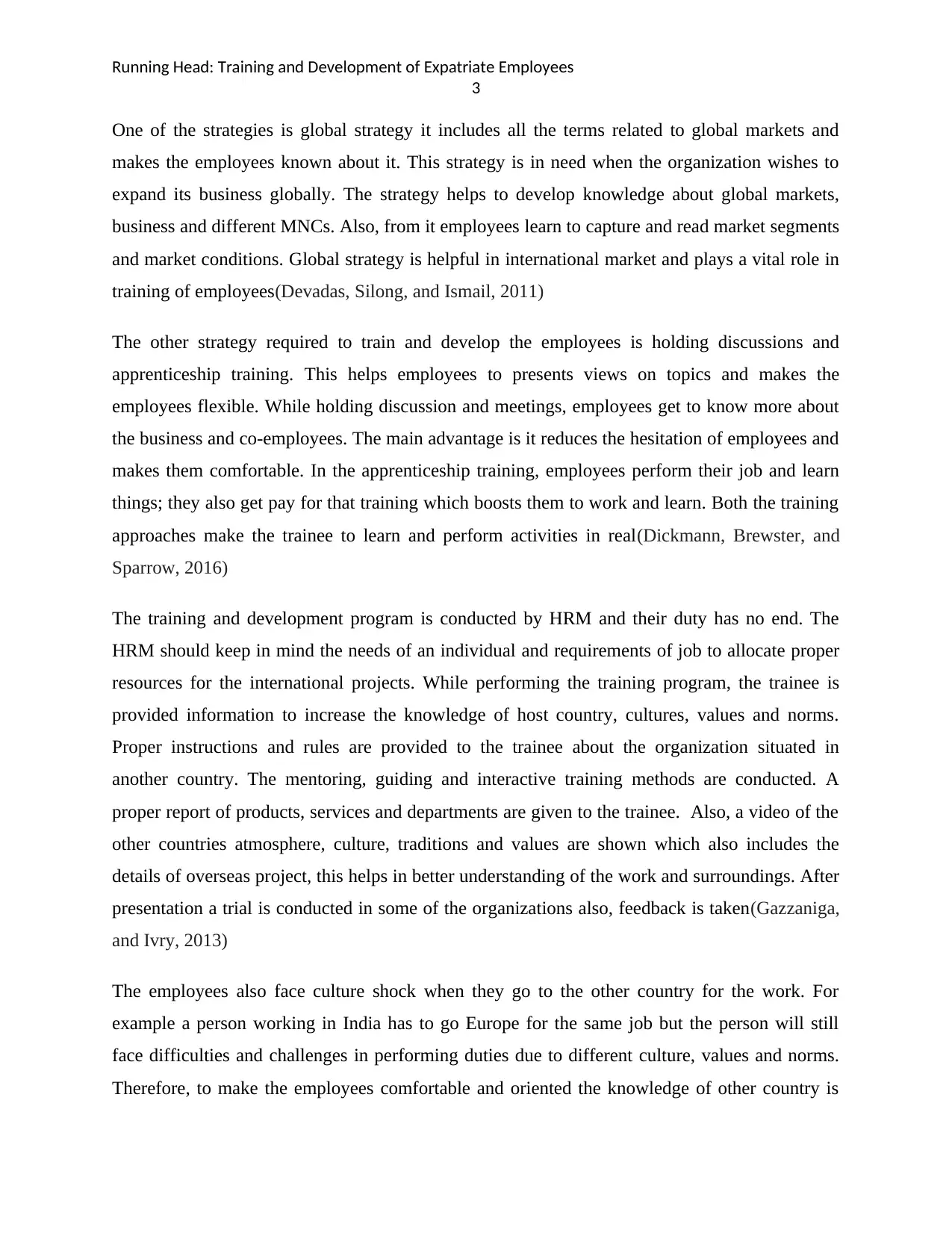
Running Head: Training and Development of Expatriate Employees
3
One of the strategies is global strategy it includes all the terms related to global markets and
makes the employees known about it. This strategy is in need when the organization wishes to
expand its business globally. The strategy helps to develop knowledge about global markets,
business and different MNCs. Also, from it employees learn to capture and read market segments
and market conditions. Global strategy is helpful in international market and plays a vital role in
training of employees(Devadas, Silong, and Ismail, 2011)
The other strategy required to train and develop the employees is holding discussions and
apprenticeship training. This helps employees to presents views on topics and makes the
employees flexible. While holding discussion and meetings, employees get to know more about
the business and co-employees. The main advantage is it reduces the hesitation of employees and
makes them comfortable. In the apprenticeship training, employees perform their job and learn
things; they also get pay for that training which boosts them to work and learn. Both the training
approaches make the trainee to learn and perform activities in real(Dickmann, Brewster, and
Sparrow, 2016)
The training and development program is conducted by HRM and their duty has no end. The
HRM should keep in mind the needs of an individual and requirements of job to allocate proper
resources for the international projects. While performing the training program, the trainee is
provided information to increase the knowledge of host country, cultures, values and norms.
Proper instructions and rules are provided to the trainee about the organization situated in
another country. The mentoring, guiding and interactive training methods are conducted. A
proper report of products, services and departments are given to the trainee. Also, a video of the
other countries atmosphere, culture, traditions and values are shown which also includes the
details of overseas project, this helps in better understanding of the work and surroundings. After
presentation a trial is conducted in some of the organizations also, feedback is taken(Gazzaniga,
and Ivry, 2013)
The employees also face culture shock when they go to the other country for the work. For
example a person working in India has to go Europe for the same job but the person will still
face difficulties and challenges in performing duties due to different culture, values and norms.
Therefore, to make the employees comfortable and oriented the knowledge of other country is
3
One of the strategies is global strategy it includes all the terms related to global markets and
makes the employees known about it. This strategy is in need when the organization wishes to
expand its business globally. The strategy helps to develop knowledge about global markets,
business and different MNCs. Also, from it employees learn to capture and read market segments
and market conditions. Global strategy is helpful in international market and plays a vital role in
training of employees(Devadas, Silong, and Ismail, 2011)
The other strategy required to train and develop the employees is holding discussions and
apprenticeship training. This helps employees to presents views on topics and makes the
employees flexible. While holding discussion and meetings, employees get to know more about
the business and co-employees. The main advantage is it reduces the hesitation of employees and
makes them comfortable. In the apprenticeship training, employees perform their job and learn
things; they also get pay for that training which boosts them to work and learn. Both the training
approaches make the trainee to learn and perform activities in real(Dickmann, Brewster, and
Sparrow, 2016)
The training and development program is conducted by HRM and their duty has no end. The
HRM should keep in mind the needs of an individual and requirements of job to allocate proper
resources for the international projects. While performing the training program, the trainee is
provided information to increase the knowledge of host country, cultures, values and norms.
Proper instructions and rules are provided to the trainee about the organization situated in
another country. The mentoring, guiding and interactive training methods are conducted. A
proper report of products, services and departments are given to the trainee. Also, a video of the
other countries atmosphere, culture, traditions and values are shown which also includes the
details of overseas project, this helps in better understanding of the work and surroundings. After
presentation a trial is conducted in some of the organizations also, feedback is taken(Gazzaniga,
and Ivry, 2013)
The employees also face culture shock when they go to the other country for the work. For
example a person working in India has to go Europe for the same job but the person will still
face difficulties and challenges in performing duties due to different culture, values and norms.
Therefore, to make the employees comfortable and oriented the knowledge of other country is
⊘ This is a preview!⊘
Do you want full access?
Subscribe today to unlock all pages.

Trusted by 1+ million students worldwide
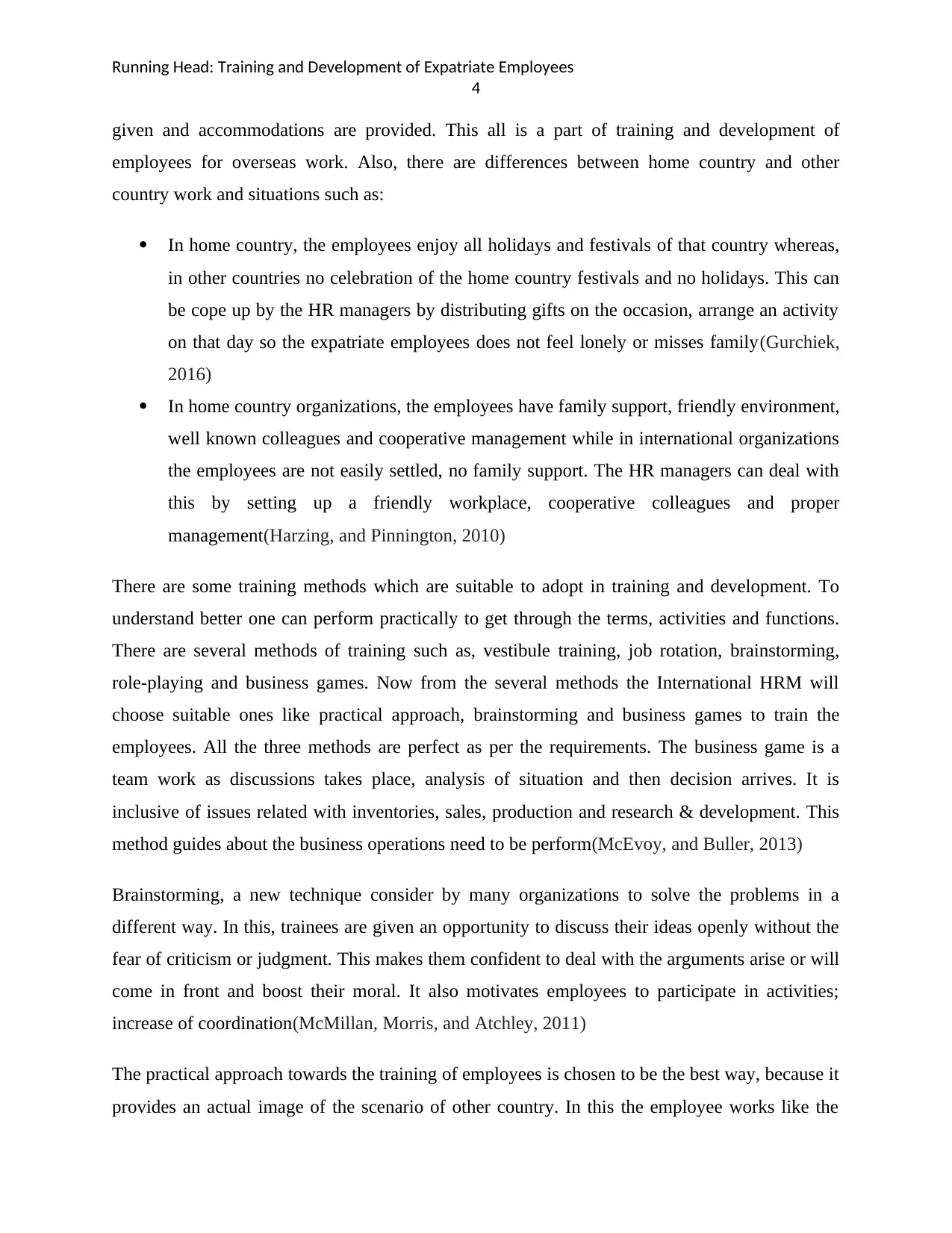
Running Head: Training and Development of Expatriate Employees
4
given and accommodations are provided. This all is a part of training and development of
employees for overseas work. Also, there are differences between home country and other
country work and situations such as:
In home country, the employees enjoy all holidays and festivals of that country whereas,
in other countries no celebration of the home country festivals and no holidays. This can
be cope up by the HR managers by distributing gifts on the occasion, arrange an activity
on that day so the expatriate employees does not feel lonely or misses family(Gurchiek,
2016)
In home country organizations, the employees have family support, friendly environment,
well known colleagues and cooperative management while in international organizations
the employees are not easily settled, no family support. The HR managers can deal with
this by setting up a friendly workplace, cooperative colleagues and proper
management(Harzing, and Pinnington, 2010)
There are some training methods which are suitable to adopt in training and development. To
understand better one can perform practically to get through the terms, activities and functions.
There are several methods of training such as, vestibule training, job rotation, brainstorming,
role-playing and business games. Now from the several methods the International HRM will
choose suitable ones like practical approach, brainstorming and business games to train the
employees. All the three methods are perfect as per the requirements. The business game is a
team work as discussions takes place, analysis of situation and then decision arrives. It is
inclusive of issues related with inventories, sales, production and research & development. This
method guides about the business operations need to be perform(McEvoy, and Buller, 2013)
Brainstorming, a new technique consider by many organizations to solve the problems in a
different way. In this, trainees are given an opportunity to discuss their ideas openly without the
fear of criticism or judgment. This makes them confident to deal with the arguments arise or will
come in front and boost their moral. It also motivates employees to participate in activities;
increase of coordination(McMillan, Morris, and Atchley, 2011)
The practical approach towards the training of employees is chosen to be the best way, because it
provides an actual image of the scenario of other country. In this the employee works like the
4
given and accommodations are provided. This all is a part of training and development of
employees for overseas work. Also, there are differences between home country and other
country work and situations such as:
In home country, the employees enjoy all holidays and festivals of that country whereas,
in other countries no celebration of the home country festivals and no holidays. This can
be cope up by the HR managers by distributing gifts on the occasion, arrange an activity
on that day so the expatriate employees does not feel lonely or misses family(Gurchiek,
2016)
In home country organizations, the employees have family support, friendly environment,
well known colleagues and cooperative management while in international organizations
the employees are not easily settled, no family support. The HR managers can deal with
this by setting up a friendly workplace, cooperative colleagues and proper
management(Harzing, and Pinnington, 2010)
There are some training methods which are suitable to adopt in training and development. To
understand better one can perform practically to get through the terms, activities and functions.
There are several methods of training such as, vestibule training, job rotation, brainstorming,
role-playing and business games. Now from the several methods the International HRM will
choose suitable ones like practical approach, brainstorming and business games to train the
employees. All the three methods are perfect as per the requirements. The business game is a
team work as discussions takes place, analysis of situation and then decision arrives. It is
inclusive of issues related with inventories, sales, production and research & development. This
method guides about the business operations need to be perform(McEvoy, and Buller, 2013)
Brainstorming, a new technique consider by many organizations to solve the problems in a
different way. In this, trainees are given an opportunity to discuss their ideas openly without the
fear of criticism or judgment. This makes them confident to deal with the arguments arise or will
come in front and boost their moral. It also motivates employees to participate in activities;
increase of coordination(McMillan, Morris, and Atchley, 2011)
The practical approach towards the training of employees is chosen to be the best way, because it
provides an actual image of the scenario of other country. In this the employee works like the
Paraphrase This Document
Need a fresh take? Get an instant paraphrase of this document with our AI Paraphraser
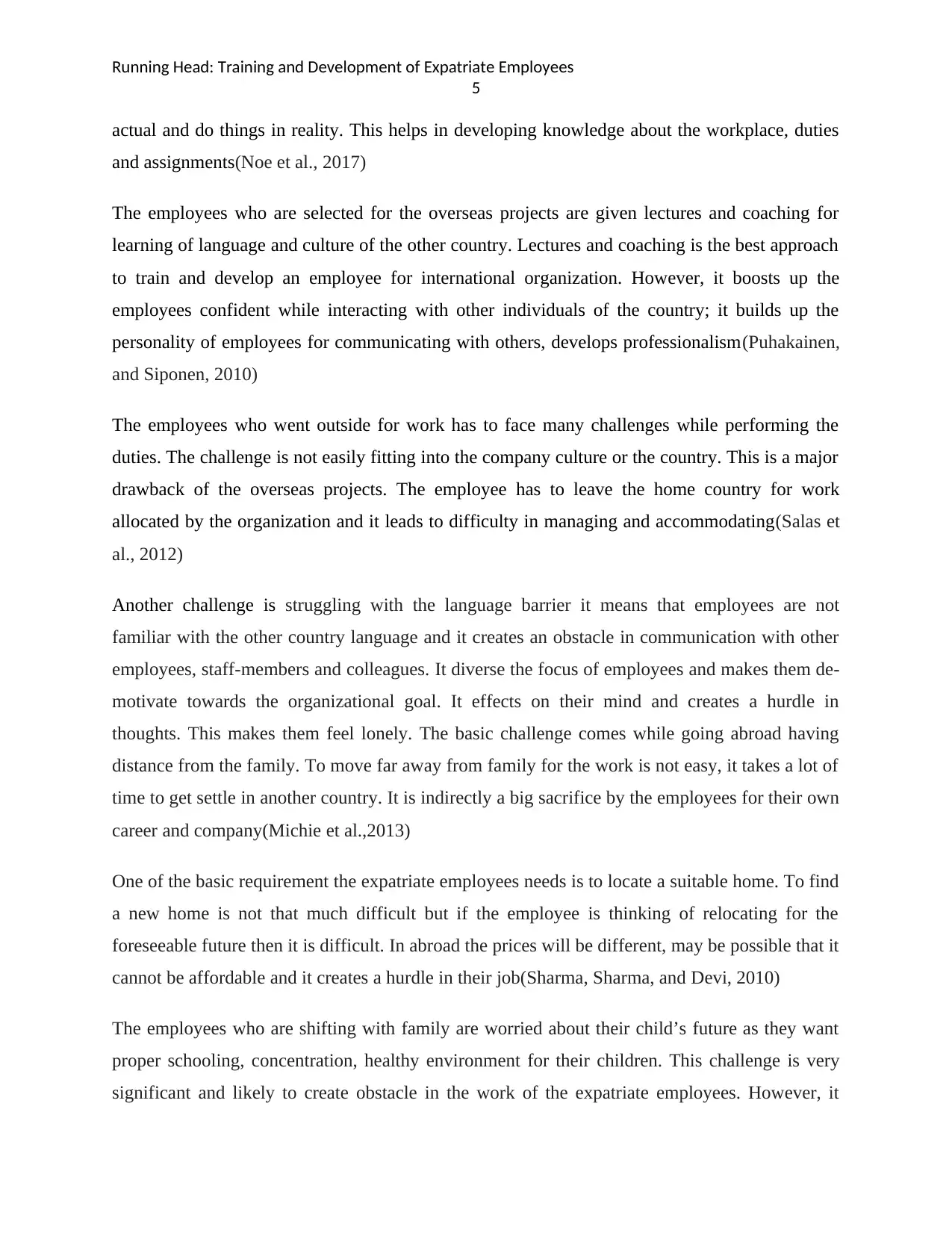
Running Head: Training and Development of Expatriate Employees
5
actual and do things in reality. This helps in developing knowledge about the workplace, duties
and assignments(Noe et al., 2017)
The employees who are selected for the overseas projects are given lectures and coaching for
learning of language and culture of the other country. Lectures and coaching is the best approach
to train and develop an employee for international organization. However, it boosts up the
employees confident while interacting with other individuals of the country; it builds up the
personality of employees for communicating with others, develops professionalism(Puhakainen,
and Siponen, 2010)
The employees who went outside for work has to face many challenges while performing the
duties. The challenge is not easily fitting into the company culture or the country. This is a major
drawback of the overseas projects. The employee has to leave the home country for work
allocated by the organization and it leads to difficulty in managing and accommodating(Salas et
al., 2012)
Another challenge is struggling with the language barrier it means that employees are not
familiar with the other country language and it creates an obstacle in communication with other
employees, staff-members and colleagues. It diverse the focus of employees and makes them de-
motivate towards the organizational goal. It effects on their mind and creates a hurdle in
thoughts. This makes them feel lonely. The basic challenge comes while going abroad having
distance from the family. To move far away from family for the work is not easy, it takes a lot of
time to get settle in another country. It is indirectly a big sacrifice by the employees for their own
career and company(Michie et al.,2013)
One of the basic requirement the expatriate employees needs is to locate a suitable home. To find
a new home is not that much difficult but if the employee is thinking of relocating for the
foreseeable future then it is difficult. In abroad the prices will be different, may be possible that it
cannot be affordable and it creates a hurdle in their job(Sharma, Sharma, and Devi, 2010)
The employees who are shifting with family are worried about their child’s future as they want
proper schooling, concentration, healthy environment for their children. This challenge is very
significant and likely to create obstacle in the work of the expatriate employees. However, it
5
actual and do things in reality. This helps in developing knowledge about the workplace, duties
and assignments(Noe et al., 2017)
The employees who are selected for the overseas projects are given lectures and coaching for
learning of language and culture of the other country. Lectures and coaching is the best approach
to train and develop an employee for international organization. However, it boosts up the
employees confident while interacting with other individuals of the country; it builds up the
personality of employees for communicating with others, develops professionalism(Puhakainen,
and Siponen, 2010)
The employees who went outside for work has to face many challenges while performing the
duties. The challenge is not easily fitting into the company culture or the country. This is a major
drawback of the overseas projects. The employee has to leave the home country for work
allocated by the organization and it leads to difficulty in managing and accommodating(Salas et
al., 2012)
Another challenge is struggling with the language barrier it means that employees are not
familiar with the other country language and it creates an obstacle in communication with other
employees, staff-members and colleagues. It diverse the focus of employees and makes them de-
motivate towards the organizational goal. It effects on their mind and creates a hurdle in
thoughts. This makes them feel lonely. The basic challenge comes while going abroad having
distance from the family. To move far away from family for the work is not easy, it takes a lot of
time to get settle in another country. It is indirectly a big sacrifice by the employees for their own
career and company(Michie et al.,2013)
One of the basic requirement the expatriate employees needs is to locate a suitable home. To find
a new home is not that much difficult but if the employee is thinking of relocating for the
foreseeable future then it is difficult. In abroad the prices will be different, may be possible that it
cannot be affordable and it creates a hurdle in their job(Sharma, Sharma, and Devi, 2010)
The employees who are shifting with family are worried about their child’s future as they want
proper schooling, concentration, healthy environment for their children. This challenge is very
significant and likely to create obstacle in the work of the expatriate employees. However, it
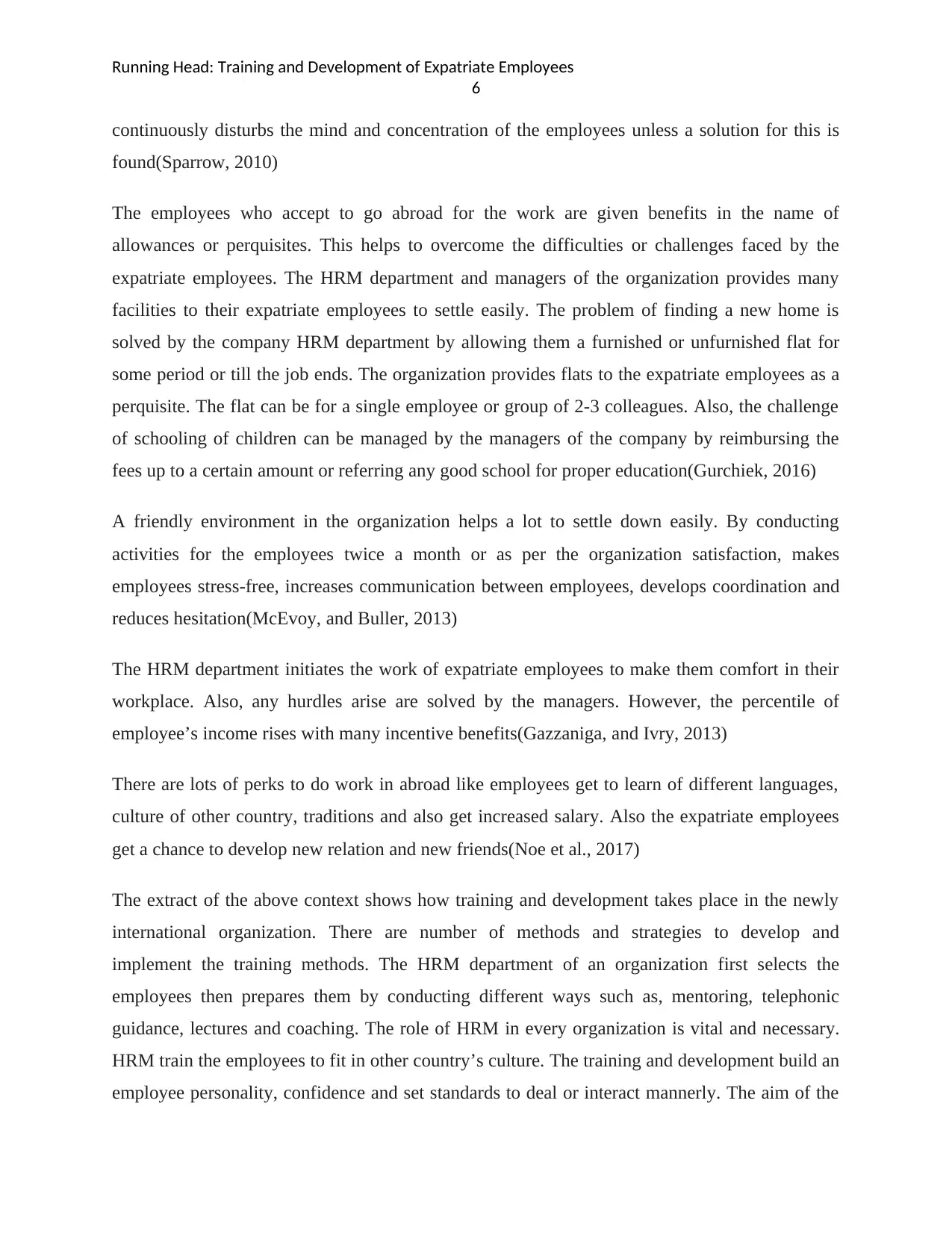
Running Head: Training and Development of Expatriate Employees
6
continuously disturbs the mind and concentration of the employees unless a solution for this is
found(Sparrow, 2010)
The employees who accept to go abroad for the work are given benefits in the name of
allowances or perquisites. This helps to overcome the difficulties or challenges faced by the
expatriate employees. The HRM department and managers of the organization provides many
facilities to their expatriate employees to settle easily. The problem of finding a new home is
solved by the company HRM department by allowing them a furnished or unfurnished flat for
some period or till the job ends. The organization provides flats to the expatriate employees as a
perquisite. The flat can be for a single employee or group of 2-3 colleagues. Also, the challenge
of schooling of children can be managed by the managers of the company by reimbursing the
fees up to a certain amount or referring any good school for proper education(Gurchiek, 2016)
A friendly environment in the organization helps a lot to settle down easily. By conducting
activities for the employees twice a month or as per the organization satisfaction, makes
employees stress-free, increases communication between employees, develops coordination and
reduces hesitation(McEvoy, and Buller, 2013)
The HRM department initiates the work of expatriate employees to make them comfort in their
workplace. Also, any hurdles arise are solved by the managers. However, the percentile of
employee’s income rises with many incentive benefits(Gazzaniga, and Ivry, 2013)
There are lots of perks to do work in abroad like employees get to learn of different languages,
culture of other country, traditions and also get increased salary. Also the expatriate employees
get a chance to develop new relation and new friends(Noe et al., 2017)
The extract of the above context shows how training and development takes place in the newly
international organization. There are number of methods and strategies to develop and
implement the training methods. The HRM department of an organization first selects the
employees then prepares them by conducting different ways such as, mentoring, telephonic
guidance, lectures and coaching. The role of HRM in every organization is vital and necessary.
HRM train the employees to fit in other country’s culture. The training and development build an
employee personality, confidence and set standards to deal or interact mannerly. The aim of the
6
continuously disturbs the mind and concentration of the employees unless a solution for this is
found(Sparrow, 2010)
The employees who accept to go abroad for the work are given benefits in the name of
allowances or perquisites. This helps to overcome the difficulties or challenges faced by the
expatriate employees. The HRM department and managers of the organization provides many
facilities to their expatriate employees to settle easily. The problem of finding a new home is
solved by the company HRM department by allowing them a furnished or unfurnished flat for
some period or till the job ends. The organization provides flats to the expatriate employees as a
perquisite. The flat can be for a single employee or group of 2-3 colleagues. Also, the challenge
of schooling of children can be managed by the managers of the company by reimbursing the
fees up to a certain amount or referring any good school for proper education(Gurchiek, 2016)
A friendly environment in the organization helps a lot to settle down easily. By conducting
activities for the employees twice a month or as per the organization satisfaction, makes
employees stress-free, increases communication between employees, develops coordination and
reduces hesitation(McEvoy, and Buller, 2013)
The HRM department initiates the work of expatriate employees to make them comfort in their
workplace. Also, any hurdles arise are solved by the managers. However, the percentile of
employee’s income rises with many incentive benefits(Gazzaniga, and Ivry, 2013)
There are lots of perks to do work in abroad like employees get to learn of different languages,
culture of other country, traditions and also get increased salary. Also the expatriate employees
get a chance to develop new relation and new friends(Noe et al., 2017)
The extract of the above context shows how training and development takes place in the newly
international organization. There are number of methods and strategies to develop and
implement the training methods. The HRM department of an organization first selects the
employees then prepares them by conducting different ways such as, mentoring, telephonic
guidance, lectures and coaching. The role of HRM in every organization is vital and necessary.
HRM train the employees to fit in other country’s culture. The training and development build an
employee personality, confidence and set standards to deal or interact mannerly. The aim of the
⊘ This is a preview!⊘
Do you want full access?
Subscribe today to unlock all pages.

Trusted by 1+ million students worldwide
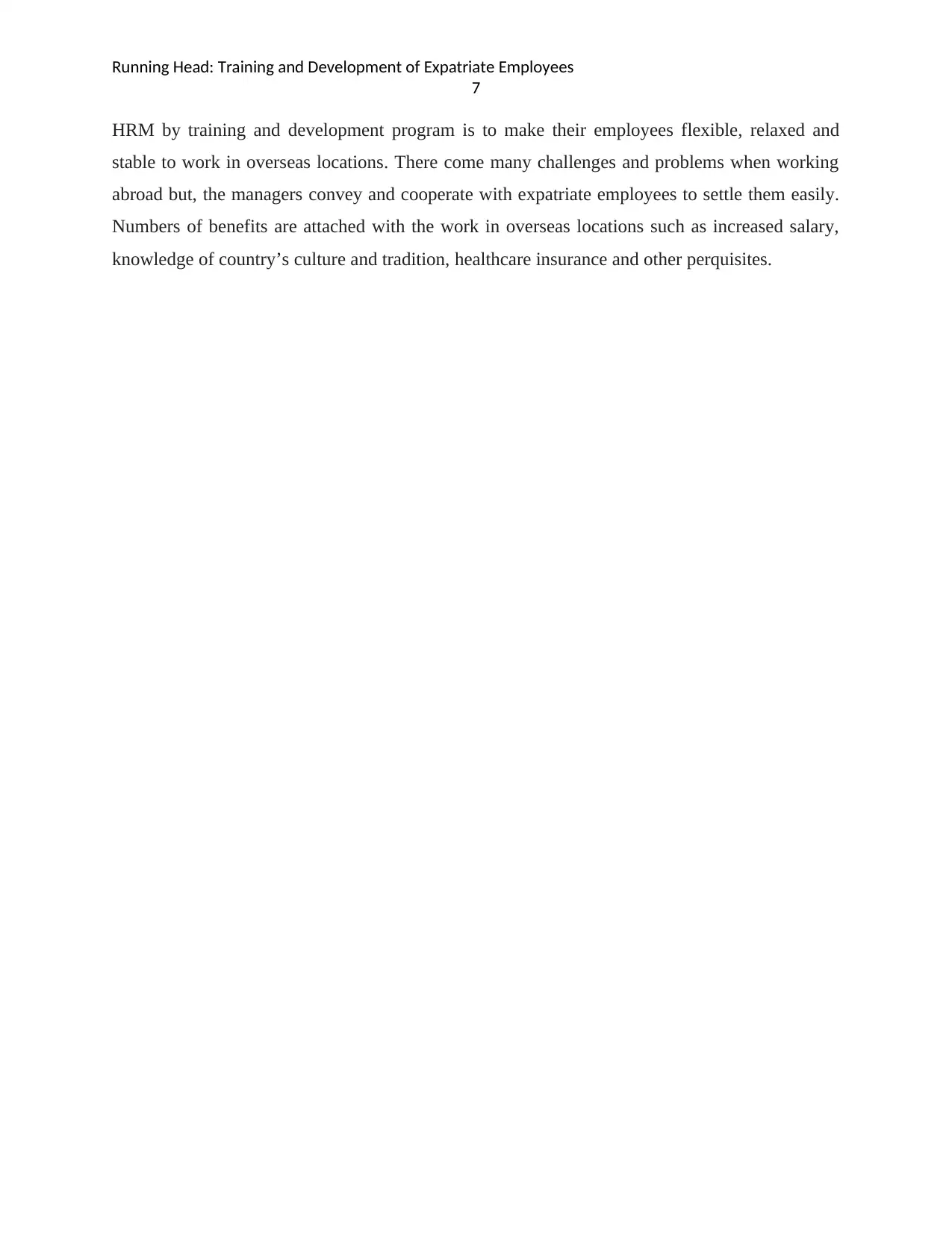
Running Head: Training and Development of Expatriate Employees
7
HRM by training and development program is to make their employees flexible, relaxed and
stable to work in overseas locations. There come many challenges and problems when working
abroad but, the managers convey and cooperate with expatriate employees to settle them easily.
Numbers of benefits are attached with the work in overseas locations such as increased salary,
knowledge of country’s culture and tradition, healthcare insurance and other perquisites.
7
HRM by training and development program is to make their employees flexible, relaxed and
stable to work in overseas locations. There come many challenges and problems when working
abroad but, the managers convey and cooperate with expatriate employees to settle them easily.
Numbers of benefits are attached with the work in overseas locations such as increased salary,
knowledge of country’s culture and tradition, healthcare insurance and other perquisites.
Paraphrase This Document
Need a fresh take? Get an instant paraphrase of this document with our AI Paraphraser
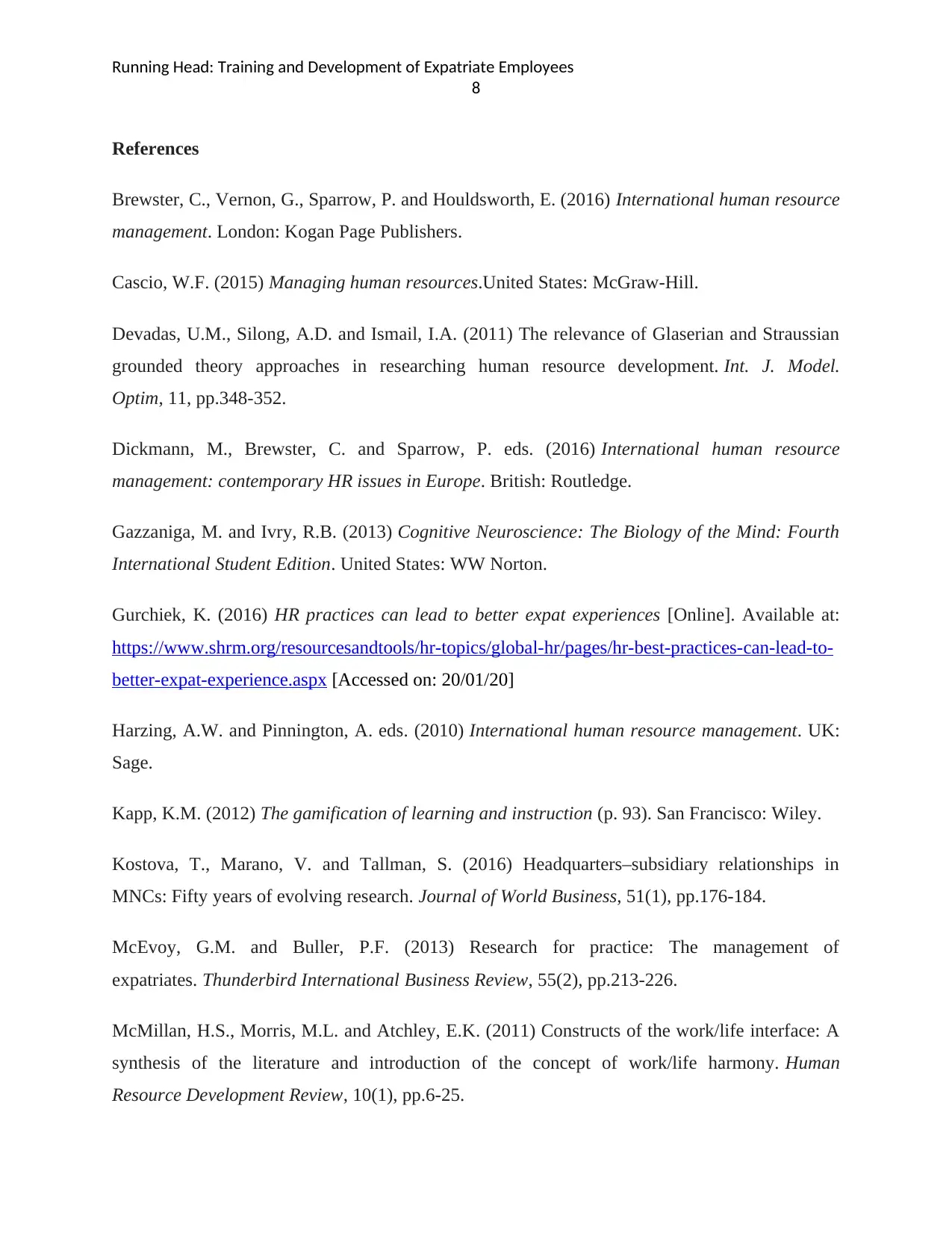
Running Head: Training and Development of Expatriate Employees
8
References
Brewster, C., Vernon, G., Sparrow, P. and Houldsworth, E. (2016) International human resource
management. London: Kogan Page Publishers.
Cascio, W.F. (2015) Managing human resources.United States: McGraw-Hill.
Devadas, U.M., Silong, A.D. and Ismail, I.A. (2011) The relevance of Glaserian and Straussian
grounded theory approaches in researching human resource development. Int. J. Model.
Optim, 11, pp.348-352.
Dickmann, M., Brewster, C. and Sparrow, P. eds. (2016) International human resource
management: contemporary HR issues in Europe. British: Routledge.
Gazzaniga, M. and Ivry, R.B. (2013) Cognitive Neuroscience: The Biology of the Mind: Fourth
International Student Edition. United States: WW Norton.
Gurchiek, K. (2016) HR practices can lead to better expat experiences [Online]. Available at:
https://www.shrm.org/resourcesandtools/hr-topics/global-hr/pages/hr-best-practices-can-lead-to-
better-expat-experience.aspx [Accessed on: 20/01/20]
Harzing, A.W. and Pinnington, A. eds. (2010) International human resource management. UK:
Sage.
Kapp, K.M. (2012) The gamification of learning and instruction (p. 93). San Francisco: Wiley.
Kostova, T., Marano, V. and Tallman, S. (2016) Headquarters–subsidiary relationships in
MNCs: Fifty years of evolving research. Journal of World Business, 51(1), pp.176-184.
McEvoy, G.M. and Buller, P.F. (2013) Research for practice: The management of
expatriates. Thunderbird International Business Review, 55(2), pp.213-226.
McMillan, H.S., Morris, M.L. and Atchley, E.K. (2011) Constructs of the work/life interface: A
synthesis of the literature and introduction of the concept of work/life harmony. Human
Resource Development Review, 10(1), pp.6-25.
8
References
Brewster, C., Vernon, G., Sparrow, P. and Houldsworth, E. (2016) International human resource
management. London: Kogan Page Publishers.
Cascio, W.F. (2015) Managing human resources.United States: McGraw-Hill.
Devadas, U.M., Silong, A.D. and Ismail, I.A. (2011) The relevance of Glaserian and Straussian
grounded theory approaches in researching human resource development. Int. J. Model.
Optim, 11, pp.348-352.
Dickmann, M., Brewster, C. and Sparrow, P. eds. (2016) International human resource
management: contemporary HR issues in Europe. British: Routledge.
Gazzaniga, M. and Ivry, R.B. (2013) Cognitive Neuroscience: The Biology of the Mind: Fourth
International Student Edition. United States: WW Norton.
Gurchiek, K. (2016) HR practices can lead to better expat experiences [Online]. Available at:
https://www.shrm.org/resourcesandtools/hr-topics/global-hr/pages/hr-best-practices-can-lead-to-
better-expat-experience.aspx [Accessed on: 20/01/20]
Harzing, A.W. and Pinnington, A. eds. (2010) International human resource management. UK:
Sage.
Kapp, K.M. (2012) The gamification of learning and instruction (p. 93). San Francisco: Wiley.
Kostova, T., Marano, V. and Tallman, S. (2016) Headquarters–subsidiary relationships in
MNCs: Fifty years of evolving research. Journal of World Business, 51(1), pp.176-184.
McEvoy, G.M. and Buller, P.F. (2013) Research for practice: The management of
expatriates. Thunderbird International Business Review, 55(2), pp.213-226.
McMillan, H.S., Morris, M.L. and Atchley, E.K. (2011) Constructs of the work/life interface: A
synthesis of the literature and introduction of the concept of work/life harmony. Human
Resource Development Review, 10(1), pp.6-25.
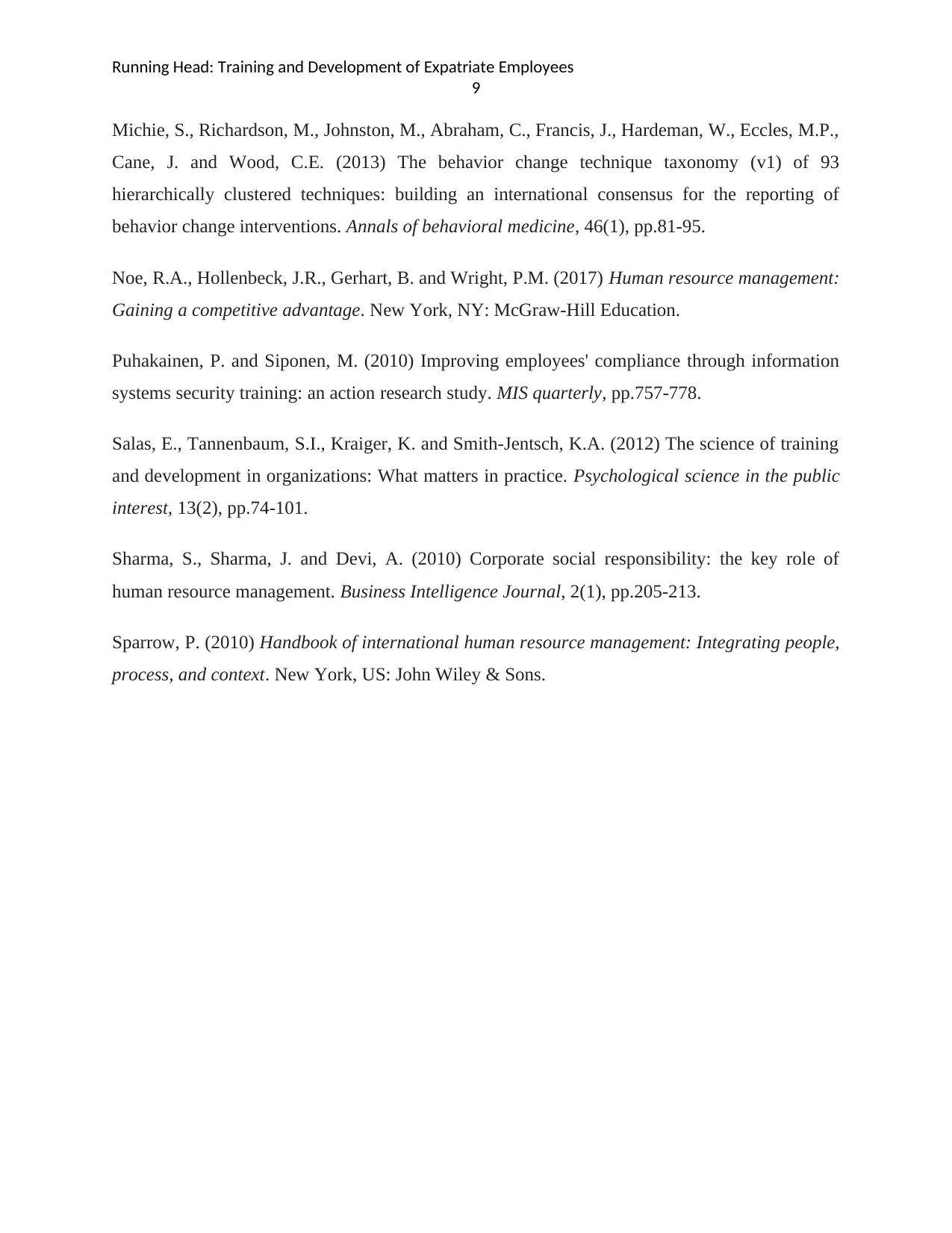
Running Head: Training and Development of Expatriate Employees
9
Michie, S., Richardson, M., Johnston, M., Abraham, C., Francis, J., Hardeman, W., Eccles, M.P.,
Cane, J. and Wood, C.E. (2013) The behavior change technique taxonomy (v1) of 93
hierarchically clustered techniques: building an international consensus for the reporting of
behavior change interventions. Annals of behavioral medicine, 46(1), pp.81-95.
Noe, R.A., Hollenbeck, J.R., Gerhart, B. and Wright, P.M. (2017) Human resource management:
Gaining a competitive advantage. New York, NY: McGraw-Hill Education.
Puhakainen, P. and Siponen, M. (2010) Improving employees' compliance through information
systems security training: an action research study. MIS quarterly, pp.757-778.
Salas, E., Tannenbaum, S.I., Kraiger, K. and Smith-Jentsch, K.A. (2012) The science of training
and development in organizations: What matters in practice. Psychological science in the public
interest, 13(2), pp.74-101.
Sharma, S., Sharma, J. and Devi, A. (2010) Corporate social responsibility: the key role of
human resource management. Business Intelligence Journal, 2(1), pp.205-213.
Sparrow, P. (2010) Handbook of international human resource management: Integrating people,
process, and context. New York, US: John Wiley & Sons.
9
Michie, S., Richardson, M., Johnston, M., Abraham, C., Francis, J., Hardeman, W., Eccles, M.P.,
Cane, J. and Wood, C.E. (2013) The behavior change technique taxonomy (v1) of 93
hierarchically clustered techniques: building an international consensus for the reporting of
behavior change interventions. Annals of behavioral medicine, 46(1), pp.81-95.
Noe, R.A., Hollenbeck, J.R., Gerhart, B. and Wright, P.M. (2017) Human resource management:
Gaining a competitive advantage. New York, NY: McGraw-Hill Education.
Puhakainen, P. and Siponen, M. (2010) Improving employees' compliance through information
systems security training: an action research study. MIS quarterly, pp.757-778.
Salas, E., Tannenbaum, S.I., Kraiger, K. and Smith-Jentsch, K.A. (2012) The science of training
and development in organizations: What matters in practice. Psychological science in the public
interest, 13(2), pp.74-101.
Sharma, S., Sharma, J. and Devi, A. (2010) Corporate social responsibility: the key role of
human resource management. Business Intelligence Journal, 2(1), pp.205-213.
Sparrow, P. (2010) Handbook of international human resource management: Integrating people,
process, and context. New York, US: John Wiley & Sons.
⊘ This is a preview!⊘
Do you want full access?
Subscribe today to unlock all pages.

Trusted by 1+ million students worldwide
1 out of 9
Related Documents
Your All-in-One AI-Powered Toolkit for Academic Success.
+13062052269
info@desklib.com
Available 24*7 on WhatsApp / Email
![[object Object]](/_next/static/media/star-bottom.7253800d.svg)
Unlock your academic potential
Copyright © 2020–2025 A2Z Services. All Rights Reserved. Developed and managed by ZUCOL.




